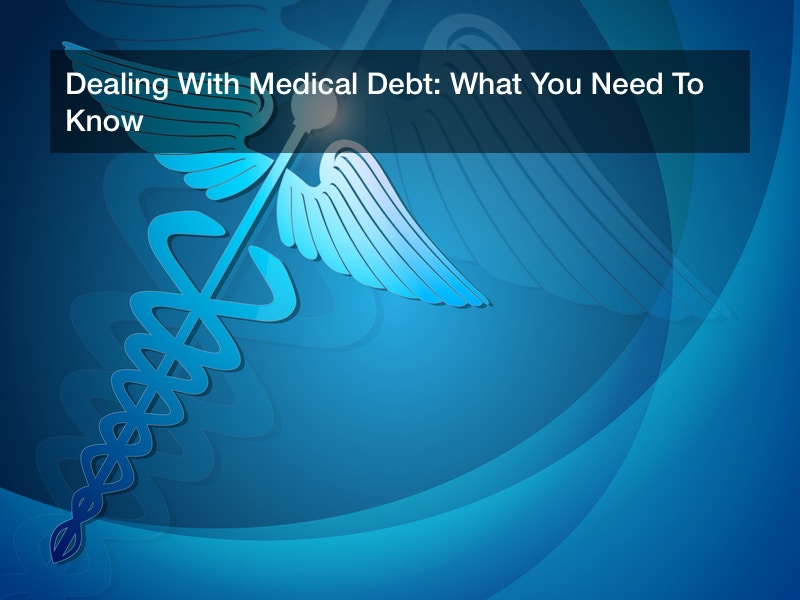Dealing With Medical Debt: What You Need To Know


Debt is something that many American households are experiencing, regardless of whether or not they’re employed during the COVID-19 pandemic. Even prior to the financial burden caused by the current economic climate, debt figured into the lives of countless people across the country, with an estimated 87% of families being categorized as being “in debt.”

The degree to which these families experience debt can range, of course. Debt can be manageable at certain rates. If handled correctly, it can be incorporated into regular monthly bills until it is fully paid off. But it’s inevitable that many individuals who anticipated being able to pay off or even simply maintain their debt are now struggling due to job loss or a reduction in pay as a response to the coronavirus.
Certain debts are avoidable and perhaps can be more easily restructured. Even student loans, among the prominent forms of the debt in the nation, are technically taken on by choice. While an individual may not be able to pay for college, they do choose whether or not to attend college in the first place. Therefore, there is a degree of planning that goes into student loans. The institutions from which a person borrows are considered ahead of time, as is the interest rate and payment plan. The same cannot necessarily be said, however, of medical debt.
Dealing with medical debt is one of the greatest stresses upon American households, as so many have this form of debt to consider. Medical debt is often taken on not by choice by necessity; while some forms of medical treatment are avoidable or can be delayed, emergency life-saving care is a different matter entirely. Furthermore, millions of people take on medical debt that is not only their own, but that of their children and sometimes even their parents. Even those with health insurance can sometimes struggle to pay their medical bills.
If anything, the pandemic potentially increases the issues surrounding medical debt because so many Americans are being hospitalized due to the disease. With that being said, there are many considerations to keep in mind when dealing with medical debt. It can be done responsibly, if planning is taken into account, and there are ways in which households can seek relief.

What Are The Leading Causes Of Medical Debt?
In theory, there should not be as many Americans dealing with medical debt in a crippling manner as there actually are. Health insurance plans should offset the seriousness of medical debt — or should at least make necessary procedures more affordable. While it’s understandable that an elective procedure like a cosmetic enhancement would be paid for out-of-pocket, something necessary like spine surgery should not cause an individual to go into such severe debt. The Affordable Care Act, in particular, was meant to ease the financial burdens caused by medical costs. But currently, medical debt is the number one reason why people file for bankruptcy in the United States.
One of the reasons why people are dealing with medical debt to such a severe degree is that their insurance plans simply don’t cover as much as they might think. While preventative care, for example, may cost nothing out of pocket, preventative care often is not what causes such severe debt. The most expensive procedures are those that treat medical crises. People may even need long-term medical care following a serious event. An individual with a long-term disability would not only have to pay for the the treatment of the medical event that caused the disability, but also the medical equipment, treatments, and any medications necessary after the fact.
A 2007 study by the American Journal of Medicine indicated that most 18.6% of medical debt in the country is made up of prescription drug costs, 15.1% is doctor’s bills, 4.1% is made up of insurance premiums, 48% is attributed to hospital costs, and the remainder is made up of “other” expenses. Essentially, every part of a doctor’s appointment or hospital visit is going to be billed one way or the other. Even a ride in an ambulance costs money, regardless of the fact that the person in the ambulance often doesn’t have a choice regarding whether or not to ride within it. Surprisingly, many of the health issues that cause the most out-of-pocket medical expenses are quite difficult to predict or avoid. These include mental illness, stroke, heart disease, diabetes, neurological conditions, or simply personal injuries. While people can make lifestyle choices to try to stay as healthy as possible, some diseases are genetically encoded into our bodies — and some personal injuries occur through absolutely no fault of our own.
Even if you don’t experience a major medical event, it can be difficult to go through life without certain treatments that improve the actual quality of your life. These types of elective procedures are not always covered by health insurance. For example, not all work-provided insurance plans offer dental care, despite the fact that this care is extremely crucial to maintaining not only the quality of an individual’s health and life overall. Another example pertains to those with chronic or debilitating conditions. If you deal with chronic pain or bone injuries, you may very well want to seek chiropractic care services. But oftentimes, this in itself can be difficult to have covered by insurance. Therefore, countless people are caught between choosing their quality of life or dealing with medical debt due to treatments that they feel they need.
It can be difficult to turn down a treatment that could, for example, relieve you of chronic back pain because you’re worried about medical debt. Many people do wait for as long as possible to seek medical treatment. But if you delay treatment, you might actually incur more debt; by failing to seek out care early on, you might be forced to turn to corrective procedures for a more serious condition. Even worse, some medical debt you may deal with may not even be yours.

Can I Be Given Another Person’s Medical Debt?
Families dealing with medical debt are often literally dealing with it as a family, with the debt being “shared” over the long term. When an individual dies, their bills do not simply disappear after the funeral services are over. In fact, not only do their loved ones have to pay for those services but they also usually are saddled with whatever medical debt was incurred during the person’s lifetime. If you die after receiving medical care, the bills you leave behind could be astronomical.
Consider the fact that quite often, senior citizens in the United States move to retirement facilities or nursing homes in their old age. Even the healthiest of seniors usually require some form of medical care — and some of them even need 24 hour care. This type of care can include hospice care, meaning that the person is receiving end-of-life care on a constant basis. It’s very easy for the bills to slowly add up, usually with the understanding that the individuals’ loved ones will inherit the debt when the time comes. While some Americans have life insurance policies that help offset these costs, life insurance is not necessarily required. In fact, many times even those with substantial debt inheritances find themselves unable to deal with both their own medical debt and that of their parents or other loved ones.
Of course, parents are not the only individuals who can pass on medical debt. All too often, adults are forced to handle the medical debt of their chronically ill or seriously injured children, even if those children pass away. It’s important to note that this not only causes severe financial repercussions, but also real emotional fallout. This kind of medical debt can be hard for an individual to get out from under, often because they’re already exhausted due to the events that caused the debt in the first place. It’s not unheard of for people to simply “give up” on paying their medical debts, instead choosing to simply let their credit scores be impacted. In the long term, they might even head towards bankruptcy. But this does not have to be the answer. There are options available for those seeking relief from dealing with medical debt and they’re more widely available than many realize.

What Are My Options If I’m Seeking Relief From Medical Debt?
Many individuals feel crushed when dealing with medical debt simply because they don’t understand their rights. Medical debt, like any form of debt, is governed by unique rules and regulations.
For one thing, starting from the beginning, you don’t necessarily have to take medical costs at face value. You can shop around for medical care, just as you would shop around for anything else. One hospital could charge one figure for a procedure, while another facility might charge exponentially less for the same treatment. More affordable care isn’t necessarily inferior, either. Certain hospitals simply cater more to specific demographics, with others being established to provide more affordable care. Some teaching hospitals will also allow patients to receive more affordable care, with the understanding that the care will be observed by or perhaps performed by interns or doctors-in-training, under the supervision of teaching doctors. Patients can also compare prices on websites like MDSave.com.
Obviously, some procedures may become more complex and therefore more expensive while a patient is sedated. This, among other reasons, is why hospitals may ask patients to sign financial consent forms, which will allow the hospital to perform procedures regardless of the costs. However, you don’t have to sign away this particular form of consent in order to be treated. This can occur even during an emergency situation.
With that being said, you may already be dealing with medical debt. Alternatively, you may need to pay a serious amount of money for medical treatment regardless of where you are treated. At times, shopping around is not always an option. Specialists can often raise their prices simply because they aren’t dealing with a lot of competition. For example, a doctor that provides specific eye disease care in your area may be able to charge more because they know that you and other patients will not able to find an alternative doctor within a reasonable distance.
Fortunately, there are still options available, whether you’re dealing with your own medical debt or inherited medical debt. Most bills are not only negotiable before care is given, but after and even during care as well. You need to look at your bills and make sure that all the care you’re being billed for was actually received. You can also look into whether or not the hospital is connected to certain charity services, which may be able to help you pay your bills if you cannot.
A payment plan is usually an option provided by most hospitals or even your family medicine office, and the payments can often be quite low. Some don’t charge interest either, as long as you make your payments on time. The next option would be, depending on the interest rates you’re dealing with, borrowing against your credit cards, your home equity line of credit, or your 401(k). It’s important to note, however, that this can potentially lead to more severe debt than what you would have been saddled with if you were just dealing with medical debt. You’ll want to think carefully before making this type of choice.
If you’re truly uncertain about where to go and what to do regarding your medical debt, it may be worth it to consult with a healthcare attorney. You may be getting taken advantage of without realizing it, and if so you need to be careful about taking action. With that being said, try not to let the way you handle your medical debt get out of hand. It can be an emotionally difficult situation to deal with, but there are always options available.


